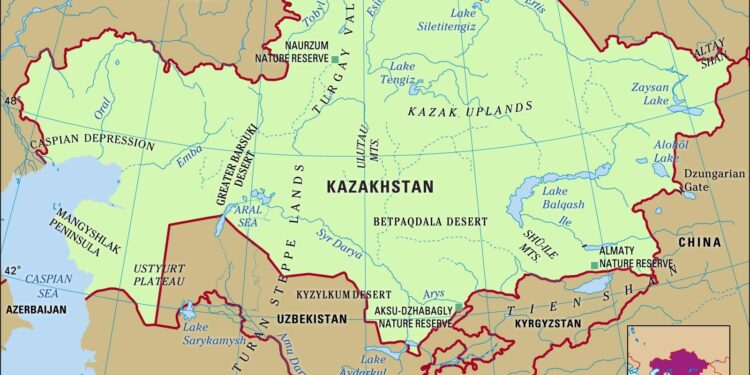Kazakhstan’s Innovative Initiative to Enhance Emergency Medical Services with Body Cameras
Kazakhstan is embarking on a revolutionary journey in emergency medical services by integrating body cameras for its healthcare professionals. This progressive initiative is designed to improve the safety of medical staff and streamline emergency response operations, showcasing a robust commitment to modernizing healthcare practices while fostering public trust. As incidents of workplace violence and high-stress situations become more common, these body cameras are expected to be instrumental in documenting events and clarifying interactions within the healthcare surroundings. This article explores the implications of this policy shift and its potential impact on emergency medical services throughout Kazakhstan.
Kazakhstan’s Vision for Enhancing Emergency Services
The rollout of body cameras for emergency medical personnel signifies a notable step forward in bolstering safety protocols and operational effectiveness within Kazakhstan’s health sector. This initiative not only aims to protect health workers but also strives to build public trust in the nation’s emergency response framework.By adopting body camera technology,authorities anticipate increased clarity that will enable real-time monitoring and precise documentation of incidents faced by medical teams during their duties. Improved documentation is expected to directly enhance training programs and response strategies, ultimately leading to better patient care outcomes.
To ensure ethical use of this technology, extensive guidelines will accompany the implementation of body cameras, prioritizing patient confidentiality alongside accountability measures. The primary objectives include:
- Enhanced Accountability: Creating clear records during emergency interactions.
- Improved Safety Protocols: Protecting healthcare workers from potential threats while they perform their duties.
- Data Collection: Gathering essential information for assessing the effectiveness of emergency responses.
This innovative strategy underscores Kazakhstan’s commitment not only towards modernizing its healthcare system but also addressing security challenges faced by frontline responders.
Evaluating Impact: Body Cameras on Worker Safety and Accountability
The introduction of body cameras among emergency medical staff represents a crucial advancement aimed at enhancing safety standards as well as accountability within healthcare environments. With growing concerns about violence against health professionals—especially during high-pressure emergencies—this initiative seeks to create an atmosphere where all interactions between responders and patients can be recorded for review purposes. Such recordings could serve as vital evidence in disputes, ensuring accountability among all parties involved.
This technological integration is anticipated not only to bolster trust between patients but also reassure families that their encounters with healthcare providers are being documented transparently. Moreover, recorded footage can serve educational purposes; it may help refine training methodologies while improving response tactics—ultimately contributing towards superior patient outcomes. The expected benefits highlight both technological advancements within healthcare as well as an urgent need for protective measures supporting those dedicated to saving lives.
Effective Implementation Strategies & Community Engagement
A successful rollout strategy for this body camera program requires establishing a structured framework that keeps all stakeholders informed and engaged throughout the process. Key strategies include:
- Thorough Training Programs: Provide comprehensive training for emergency personnel on effective camera usage along with understanding legal implications associated with recordings.
- Crisp Policy Progress: Create clear guidelines regarding operational protocols, data management practices, and privacy issues related specifically to handling camera footage.
- Civic Engagement Initiatives: Encourage community involvement through forums designed specifically for addressing concerns while gathering feedback that positively shapes program development.
- Status Updates & Reporting Mechanisms: Maintain open dialog through regular updates regarding performance metrics directly linked back towards overall objectives set forth when launching this program!
Nurturing community engagement remains essential toward achieving acceptance alongside effectiveness surrounding these initiatives! Strategies promoting such involvement might encompass:
- A Public Awareness Campaign Initiative: Launch campaigns aimed at educating citizens about how utilizing these devices considerably enhances transparency plus accountability levels!
- Collaborations With Local Organizations: Partner up alongside NGOs/community leaders facilitating discussions enhancing mutual trust between parties involved!
- Feedback Channels Creation: Set up avenues allowing residents express opinions/experiences relating back towards implemented programs effectively!
- Evaluation Reports Publication: Regularly release findings assessing impacts made via use cases observed throughout communities served including improvements noted around service delivery times too!
Final Thoughts:
As Kazakhstan moves forward with equipping first responders using advanced technologies like wearable video recording devices; government officials emphasize their commitment toward strengthening security/accountability frameworks already present today’s fast-paced world we inhabit now more than ever before! Integrating cutting-edge tech solutions into daily operations ensures protection afforded those working tirelessly saving lives daily whilst concurrently fostering greater public confidence surrounding overall efficacy delivered via local health systems available nearby too ! Monitoring progress closely once pilot phases commence becomes imperative moving forward tackling any arising challenges head-on together collaboratively amongst various stakeholders involved alike. Observations made globally indicate similar efforts undertaken elsewhere may provide valuable insights guiding future endeavors aiming bolster protections offered across diverse sectors worldwide alike!
















